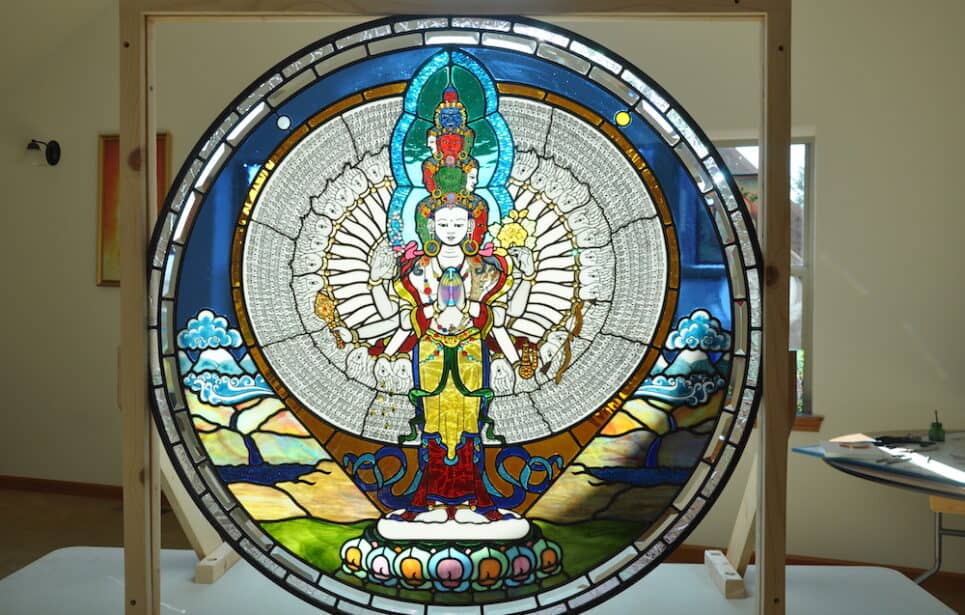Bringing Avalokiteshvara into the circle
By D. E.

Restorative justice conceives of justice as repair to the harm caused by crime and conflict, rather than punishment. Understanding and responding to the needs of all parties involved and the broader community is central to the collective creation of a just outcome. As part of a restorative justice program, D.E. had a three-day experience meeting with survivors of violent crimes. Here are some of his reflections on the three days.
Day One
The session facilitator had asked us all to “bring” someone into the circle, someone who would support us over the next three days. (I brought my Dad.) One of the other men said he had no one to bring into the circle. I felt so bad for him! I didn’t do this “out loud,” but I invited Avalokiteshvara into the circle on his behalf. I had not been doing so previously, but I started to bring my mala to the classes after this. I chanted Om Mani Padme Hum on the mala, hoping to make it easier for Avalokiteshvara or Kanzeon to find us.
In the afternoon session, we had a guest speaker. She told us of how she had lost her grandmother—her Memaw—to a violent, horrific crime. The speaker had made seven points about how surviving the crime had affected her. The one that stuck out most to me: Surviving crime is lonely.
The people who knew what she had been through did not know how to approach her, how to talk to her. She was not physically there when her Memaw was killed, but due to the way people avoided the speaker after the crime (because they didn’t know what to say/ how to act) she felt utterly alone.
Day Two
Day two brought us another guest speaker; another survivor of violent crime. Her son was killed in an armed robbery. She spoke of the added trauma she had endured watching the video surveillance tapes of the robbery and killing in process.
Two offenders were involved, and she endured added trauma sitting through both of their criminal trials. There was a mistrial of the first offender, she had to sit through his trial and his retrial. She receives restitution checks from the state where the crime occurred. Every time either offender has money added to his account, she gets a percentage. Inmates make money for serving their time (I get $0.05 an hour, 40 hours a week). She gets a percentage of any money added to their accounts. So sometimes, her restitution check may be for as little as $2. Every restitution check she gets has the case number printed on it—those checks make her relive the crime again and again.
She told us that one time the bank teller saw that she was upset—very upset. The teller got her to share her story. Afterwards, the teller got the bank’s manager and told her story. The manager told her, going forward not to even open the envelopes with those restitution checks. Bring the envelopes to the bank, they’ll open them, endorse the checks, and deposit the money in her account. I was moved by that!
The mood for the afternoon session was very somber. We were asked to share our reactions to that morning’s guest (the guest was still with us via Zoom). The inmate to speak ahead of me was the same person for whom I had invited Avalokiteshvara to the circle. I don’t know, I think he responded! He shared a story of having lost his stepfather to a violent crime. Unlike either of the guest speakers, he was right there as the crime was being committed. I now had my mala with me, and I started chanting to myself the sutra for protecting life.
(From Lion’s Roar magazine, I have learned an English translation of the sutra):
Kanzeon! At one with Buddhas
Related to all Buddhas
In cause and effect
And to Buddha, Dharma, and Sangha
Joyful, pure, eternal being.
Morning mind is Kanzeon.
Evening mind is Kanzeon.
This very moment arises from mind
This very moment is not separate from mind.
I’ve been chanting it seven times every day since.
At the end of the second day, we were asked to make a creative piece in response to both guest speakers’ stories.
Day Three
In the afternoon, we offered our creative projects. I began by reading Portia Nelson’s “There is a Hole in My Sidewalk.” After reading it, I said that I had realized—the night before—that they weren’t looking for me to share someone else’s creation, they wanted one of my own. I strung a mala. Every other bead was actually a group of three small beads; one sapphire, one crystal, and one gold. I explained the Triple Treasure, particularly the sangha. These colored beads are meant to represent the Triple Treasure. To me, the sangha speaks to both speaker’s stories. I don’t want to be part of a community that leaves a victim feeling all alone. I’d rather be part of one that, like that bank manager, tries to lift a victim’s pain from them and carry it themselves.
More thoughts on restorative justice by D.E.:
Incarcerated people
Many incarcerated people from all over the United States correspond with Venerable Thubten Chodron and monastics from Sravasti Abbey. They offer great insights into how they are applying the Dharma and striving to be of benefit to themselves and others in even the most difficult of situations.


